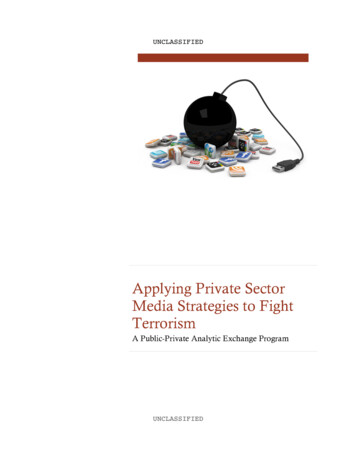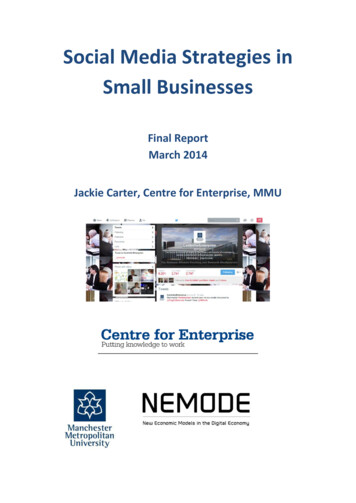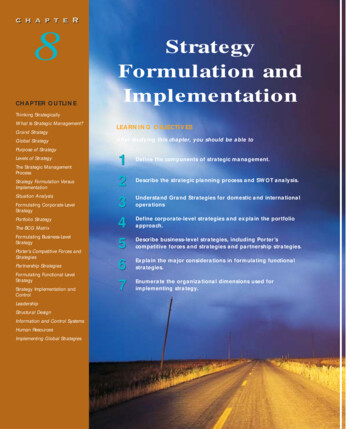
Transcription
UNCLASSIFIEDApplying Private SectorMedia Strategies to FightTerrorismA Public-Private Analytic Exchange ProgramUNCLASSIFIED
Public-Private Analytic Exchange ProgramTable of ContentsApplying Private Sector Media Strategies to Fight Terrorism . 1Introduction . 1Executive Summary . 2I: Defining the Problem . 4Government Widely Acknowledges Challenge . 5Findings from the 2016 Public-Private Analytic Exchange Program (AEP) . 6Lack of overarching strategy . 6Bureaucratic obstacles . 7Inability to compete with volume . 7Lack of credibility . 7Challenges to audience segmentation . 8Honing the response. 8Over reliance on social media tools . 8Need for improved coordination . 8II: Tools and Methods of the Private Sector. 9Find the Right Audience: Segmentation . 9Company Spotlight: Brandwatch . 9Find the Right Messenger: Building Credibility through Partnerships . 10Build partnerships . 11Anticipate the long game . 11Identify and understand messaging channels . 12Find the Right Message . 13Company Spotlight: Persistence of Vision . 13Focus on strengths . 13Plan a proactive response . 14Changing the Landscape . 16Applying Private Sector Media Strategies to Fight Terrorismii
Public-Private Analytic Exchange ProgramIII: Foundations of Sustainable Collaboration . 17Features of Sustainable Collaboration. 17Establishing effective goals and objectives . 17Empowerment of credible voices . 17Massively open, online engagement . 18Annual Public-Private Sector Collaboration and Summit Concept. 19Governance structure . 19Potential participants . 19Annual cycle . 20Proposed activities . 20§Timeline . 22§Host . 22§Attendees . 22§Cost . 22§Locations . 22§Agenda . 23Applying Private Sector Media Strategies to Fight Terrorismiii
Applying Private Sector Media Strategies toFight TerrorismIntroductionRepresentatives of the public and private sector convened under the IntelligenceCommunity (IC) Analyst Private Sector Program and later the Public-Private AnalyticExchange Program in a team focused on Applying Private Sector Media Strategies to FightTerrorism. The Media Strategies Team conducted meetings with private and public sectorrepresentatives from mostly US-based companies and entities from April through July of2015 and from January to July 2016 to identify strategies that could be applied in USgovernment-led efforts to counter extremist messaging.Applying Private Sector Media Strategies to Fight Terrorism1
Executive Summary“It is just plain embarrassing that al-Qaeda is better at communicating its message onthe Internet than America. As one foreign diplomat asked a couple of years ago, “Howhas one man in a cave managed to out-communicate the world’s greatestcommunications society?” Speed, agility, and cultural relevance are not terms thatcome readily to mind when discussing US strategic communications.”– Former Secretary of Defense Robert M. Gates, November 2007The ideological threat of violent extremism is a global problem with domestic implications.Extremist groups conduct continuous communications campaigns, targeting vulnerable andreceptive individuals to get them to self-radicalize and conduct violence in the name ofextremist ideologies. As evidenced by Americans who have joined terrorist organizations orconducted mass casualty attacks, such as those witnessed in Orlando, Florida, and SanBernardino, California, the implications of violent extremist propaganda campaigns arebecoming more complex, more widespread, and more deadly.The United States government (USG) currently spends billions of dollars each year tounderstand, communicate with, and engage various audiences, but its efforts in counteringextremist propaganda remains fractured, uncoordinated, and inefficient. There have beennumerous studies, reports, and reviews identifying problems and recommending solutionsbut no sustained success. There have also been attempts to enlist America’s private sector tofight terrorism. From the 2002-appointment of former Madison Avenue advertisingexecutive Charlotte Beers as Under Secretary for Public Diplomacy and Public Affairs to therecent effort to assemble a “Legion of Superheroes of the Madison Avenue crew” in the Fallof 2015, the USG has been enchanted with idea of unleashing the power of, what formerSecretary of Defense Robert Gates called, “the world’s greatest communications society.”The Media Strategies Team conducted interviews with over 22 private sector andgovernment entities to understand how the USG and partner nations can comprehensivelydeal with the intractable problem of Countering Violent Extremism (CVE) through thekinds of smart media strategies that private sector marketing, social media, political andother concerns employ. These entities, experienced in developing a brand and dealingeffectively with an audience, communicated that the best messaging campaigns use astorytelling approach, have an emotional appeal, and leverage effective visual imagery.Applying Private Sector Media Strategies to Fight Terrorism2
This three-part paper outlines the CVE problem space noting key public and private-sectorcriticisms of recent CVE approaches; relevant tools in the private sector community,including non-profit and for-profit capabilities on social media; and finally, outlines apotential model of a sustainable engagement communications platform to deal with CVEleveraging to bridge entities. This paper also focuses our efforts to capture the potential ofcollaborating with the private sector without rehashing previous recommendations for oneoff efforts. In this paper, we recommend options for ongoing sustainable collaboration thatwill encourage the best private sector solutions while saving tax dollars by coordinatingresources across government and avoiding duplication of effort.The team intends for this information to inform analysts, policymakers, and private-sectorentities seeking to create lasting solutions in the CVE space. We also aim to broaden thetoolbox for government leaders and advocate for a unified approach between the GlobalEngagement Center (GEC), Department of Defense (DoD), and Department of HomelandSecurity (DHS).Applying Private Sector Media Strategies to Fight Terrorism3
I: Defining the ProblemBoth foreign and domestic terrorist organizations use sophisticated messaging to promotetheir brand of violent extremist ideology. The messaging is aimed at receptive or vulnerabletargets, with the aim to influence individuals to support or engage in acts of violence infurtherance of that ideology. This may manifest in the form of an individual joining orproviding material support to a terrorist organization, or the individual may become a homegrown violent extremist inspired by, but not directly collaborating with a terroristorganization. The US is presented with the challenge of countering that messaging.For example, Islamic violent extremist media campaigns from terrorist organizations, suchas the Islamic State in Iraq and the Levant (ISIL) and al-Qa’ida, use global influence andminimal effort to achieve high impact results. Despite setbacks in their operational zonesabroad and decreased recruitment of foreign fighters from Western countries, the groups’continued calls for violence and attacks against the US continue to be answered. Further, asdemonstrated by the attacks in Paris, returning terrorist foreign fighters immersed in theterrorist organizations’ messaging pose a dangerous and costly operational threat.Violent extremist groups, members, and safe havens have dramatically increased abroad inthe past 15 years despite the US War on Terror. With the increased use of social media, theappeal of these groups is global- and at home. Kinetic campaigns alone are insufficient asglobal support enables terror groups to regenerate strength quickly. To degrade their abilityto regenerate, more needs to be done to curb the appeal of these groups and promotesocietal resilience against their messaging in the US. Unless the USG can curb this appeal,kinetic operations amount to little more than scooping water out of a sinking ship withoutfirst plugging the hole.Applying Private Sector Media Strategies to Fight Terrorism4
Government Widely Acknowledges Challenge“Countless studies, articles, and opinion pieces have announced that US strategiccommunication and public diplomacy are in crisis and inadequate to meet currentdemand There is disagreement among the various sources about exactly whatchanges are required. These may include realignment at DOS, a reorganization atDoD, a coordinating authority at the NSC level, or all of the above ”- Whither Strategic Communication? A Survey of Current Proposals andRecommendations, 2009Since the beginning of the Global War on Terror, the USG has been aware of theimportance of engaging violent extremist groups in the media space, and civilian, military,and political leaders, including both Republicans and Democrats, agree that a keycomponent of winning the "war on terror" is defeating the ideology that supports terrorism.For this effort and others, the USG currently spends billions of dollars each year tounderstand, communicate with, and engage foreign and domestic populations. Thesestrategic communications activities are conducted through the Department of State (DOS),DoD, the Broadcasting Board of Governors (BBG), the Federal Bureau of Investigations(FBI), DHS, and multiple other agencies within the Intelligence Community (IC). Thenumerous departments and agencies involved are often duplicative, uncoordinated, orineffective and do not agree on a common lexicon. The strategic messaging againstterrorism falls across fields of endeavor, to include public diplomacy, psychologicaloperations, information operations, public affairs, military information support operations,and influence operations. Further, there are ad-hoc coordinating committees and structureshoused in DoD and DOS, but they lack the budget or the authority to effectively coordinategovernment-wide strategic communications.After the terrorist attacks in 2001, it became clear that the US strategic communicationscapability had deteriorated since the end of the Cold War. Budgets were deeply cut in the1990s, and the cadre of valued specialists from the US Information Agency was reassignedto DOS. To address the threat posed by al-Qa’ida and fight the subsequent wars inAfghanistan and Iraq, DoD dramatically increased its information and influence capacity,in part, because of a lack of civilian capability and capacity. However the growth in DoD’srole in strategic communications has been accompanied by conflicts with civilian agencies.Applying Private Sector Media Strategies to Fight Terrorism5
In a 2008 speech, Secretary of Defense Robert Gates admitted, “The United States militaryhas become more involved in a range of activities that in the past were perceived to be theexclusive province of civilian agencies and organizations.” A specific example can be foundin the dozens of Army Military Information Support Teams (MISTs) working at USEmbassies around the world, assisting DOS with strategic communications. With PresidentObama’s inauguration in 2009 came a new push for “re-balancing” military and civiliancapabilities, but a lack of funding, capacity, and professional development left civilianagencies ill equipped to reclaim these responsibilities from the DoD.The problems with US strategic communications have not gone unnoticed. There have beendozens of reports and studies conducted by the Defense Science Board, the GovernmentAccountability Office, the Congressional Research Service, as well as a variety of thinktanks. To address the failure of America’s broadcasting and public diplomacy organizationsto function effectively since 9/11, former Senator Sam Brownback (R-KS) introduced “TheStrategic Communications Act of 2008” (S.3546), and in March of 2010, Congressmen MacThornberry (R-TX) and Adam Smith (D-WA) formed a “Strategic Communication andPublic Diplomacy Caucus” to raise awareness of its challenges and to provide multipleperspectives on proposed solutions. Efforts to improve have continued, including theJanuary 2016 announcement that DOS was standing up a new GEC to more effectivelycoordinate, integrate, and synchronize CVE communications to foreign audiences thatundermine the disinformation espoused by violent extremist groups, including ISIL and alQa’ida, and that offer positive alternatives. Unfortunately, these efforts have not remediedthe still fractured USG strategic communications community.Findings from the 2016 Public-Private Analytic Exchange Program (AEP)From interviews with US strategic communication officials and analysts, we identifiedseveral key criticisms of past and current practices:Lack of overarching strategyA perception exists among private sector participants that there is a lack of a coherentstrategy among the whole of the US government. This is reinforced by the shifting nature ofentities, the lack of coordination among CVE institutions, and consistent turnover. Therecent creation of the GEC underscores this argument, implying that previous efforts werenot effective. While the GEC has made progress in attempting to coordinate, integrate, andsynchronize messaging to foreign audiences, there is still a lack of an overarching strategyfor USG’s efforts to message domestic audiences. The GEC is not budgeted or resourced toApplying Private Sector Media Strategies to Fight Terrorism6
effectively manage a whole of government effort. It is also hampered by legal barriers tostrategy and message coordination with agencies involved in domestic communications andoperations, such as the FBI and DHS. This has resulted in the development of multipleagency-level strategies.Bureaucratic obstaclesThe USG's bureaucratic structure hinders effective CVE activities. As a result, it is neithernimble nor quick enough to react to or proactively outmaneuver ISIL messaging campaigns.Too many actors, inefficient coordination, and conflicting lines of authority stagnate theprocess of producing guidance and messaging. The USG is structurally averse to risky,nimble, quick, adaptable, and iterative processes - all of which are required to take on ISIL'media machine.Inability to compete with volumeISIL messages overwhelm western governments, including the USG. The USG is notstructurally equipped to deliver volume on par with ISIL’s current production. By the end of2014, ISIL had put out 100,000 tweets a day compared to 100 or 200 from the Center forStrategic Counterterrorism Communications (CSCC)1. In 2015, there were approximately200 self-declared anti-ISIL organizations around the world compared to 20,000 identifiedpro-ISIL accounts on social media. Currently, the USG is unable to compete directlyagainst ISIL's messaging volume. In addition, finding content from third parties, such asnonprofit groups or religious leaders, which the government finds worth backing is also aproblem. There is not enough such content, nor is there a mechanism to credibly promote it.Lack of credibilityThe USG is not a credible messenger in Muslim communities. First, its policies in theMiddle East are negatively viewed, and it is widely associated with “waging a war againstIslam" in the service of Israel. This undermines the USG’s ability to persuade Muslimaudiences. Secondly, the USG willfully does not engage ISIL on theological grounds. Third,CVE involves all those whom extremists love to hate: intelligence services, police,mainstream preachers, and local communities. Communities around extremists have mixedfeelings about messages from a government that is tasked with both protecting andprosecuting Muslims.1The CSCC is an American government enterprise established in 2011 at the direction of the President and theSecretary of State to coordinate, orient, and inform government-wide foreign communications activitiestargeted against terrorism and violent extremism.Applying Private Sector Media Strategies to Fight Terrorism7
Challenges to audience segmentationISIL messaging is more effective than current USG messaging efforts, as demonstrated byISIL’s successful recruitment of youth in the US. While it is unrealistic to reach thosealready radicalized by ISIL, as the USG has difficulties identifying and segmenting preradicalized audiences, it messages many people whom do not require inoculation againstISIL ideology. This could cause unanticipated blowback. The USG and its proxies mustdirect the right speech towards the right audiences.Honing the responseThe USG is always tempted to respond rationally and critically to the arguments made byISIL. Countering faith with facts does not convince those who are radicalized or in theprocess thereof. The USG and its proxies must speak to their values and grievances, orotherwise redirect their attention.Over reliance on social media toolsThe USG is too focused on social media tools. While ISIL has a very successful socialmedia operation, it owes that success to its appeal and message, not to the medium itself.The USG must not focus exclusively on social media, forsaking traditional media or peer-topeer interactions.Need for improved coordinationThere are abundant examples of regional CVE conferences, but these efforts are notcoordinated into a coherent action plan. While CVE often follows the mantra that all effortsshould be “local,” there are relevant lessons learned that could be exported on aninternational basis to complement an overarching strategy.Applying Private Sector Media Strategies to Fight Terrorism8
II: Tools and Methods of the Private SectorSeveral key themes and tools emerged in meetings and discussions with private sectorpartners that could be leveraged to enhance government communications efforts in CVEmessaging. Private sector partners who provided insight to the team are highlighted in thissection.Find the Right Audience: SegmentationPrivate sector partners discussed the importance of segmenting the communicationsaudience to reach the desired groups. There is a spectrum ofaudiences with different needs and trying to reach all of themwith a single message results in a broad and ineffectivemessage. One practitioner emphasized that it is tempting toconflate various groups, but emphasized a highly distinctbreakdown of the intended audience to the regional and locallevel matters in effective messaging. Several companiesstressed the need to appeal locally, noting that the themes and cultural context needed tomessage against, for example, would differ from Syria to Europe to the homeland. Evenwithin the homeland, film executives reported that different messages worked in differentparts of the country. Messaging that was not narrowly targeted risked creating moreproblems than it aimed to prevent; for example, vulnerable people on the cusp could befurther radicalized if they receive the wrong message. Partners suggested launching thestrategy from desired outcomes and working back to find which audiences, interlocutors ormiddleman in the conversation, and messages were likely to generate the desired goal. Somesuggested considering family members of the radicalized as a potential audience. Onepartner gave the example of an extremely successful campaign in partnership with theColombian government that targeted mothers to convince their children fighting with the“There is noone-size-fits-allapproach.”Company Spotlight: BrandwatchBrandwatch, headquartered in Brighton, United Kingdom, with US-offices in New York and SanFrancisco is a social intelligence company. Its analytics platform gathers online conversations every day andprovides users with the tools to analyze them to facilitate data-driven business decisions. Clients includeincluding Cisco, Whole Foods, Whirlpool, British Airways, Sony Music, and Dell.Applying Private Sector Media Strategies to Fight Terrorism9
FARC to come home for Christmas in exchange for immunity that was temporarily madeavailable in coordination with the campaign. The campaign resulted in numerousdefections.Private sector tools help in segmentation and achieving a more detailed picture of potentialaudiences. A key tool is “social listening” in which companies monitor social media outletsto track themes and trends online. Social media analysts monitor the web across 18 millionsites a day in multiple languages and are able to build precision around the “noise.” Aresearch company said they try to break down the questions for a client and used theanalogy that the client might be interested in the broad category of ice cream, but the toolsat their disposal allow them to come back with details on what flavors and combinationspeople are talking about online. Twitter profiles can be monitored and the audiencesegmented on available biographic information, interests, and interaction.Once the audience is identified, understanding its motivations is central to crafting thestrategy and message to influence behavior. An advertiser held up the example of Motel 6,lauding its treatment of being thrifty and frugal as a preference and a demographic over anincome level, leading to a more lifestyle-driven campaign that seeks an emotionalattachment to “downhome” fun over simply emphasizing low cost rooms. (RichardsGroup)Find the Right Messenger: Building Credibility through PartnershipsPrivate sector partners frequently raised the importance of finding the right interlocutor tobuild rapport with the target group. Several discussants raised the prospect that the US is nota credible interlocutor and indicated behind-the-scenes support would be more effective thandirect messaging. One described a “trust deficit” dogging the US government in theaftermath of 9/11 that would complicate messaging efforts, especially among youngerpeople, and would be best regained through finding partners at thecommunity level. Influence mapping, the practice of identifyingdrivers of decisions in a group and which parties they are most ableto persuade, can prove a helpful tool in identifying potentialpartners. The aim of counter-messaging is frequently to change abehavior or belief. Messaging strategies will benefit from havingpartners who understand the mindset of the target audience on thelevel needed to reach them enlisted to help.“We have torecruit andmaintain acoalition.”Applying Private Sector Media Strategies to Fight Terrorism10
Build partnershipsSeveral private sector representatives underlined partnerships as a way to overcome thiscredibility gap, advising to recruit and maintain a coalition of partners to help transmit keymessages, and add to the government’s limited ability to reach a wider audience. It is alsonecessary to find the values that drive influential relationships among the target audienceand determine the basis of respect in the culture to be influenced. For example, scholars ofIslam are at a disadvantage to recruiters, who are typically young enough to understandtheir target audience and seem approachable, but old enough for potential recruits to lookup to. Cultural touchstones are important. One adviser pointed out that the US is atransaction-based economy trying to penetrate more “relationship-based” economieselsewhere in the world. He described a key potential factor for success as building a networkof interlocutors to amplify US messages and counseled to not discount the importance ofperson-to-person exchanges in bolstering these networks. Such groups, according to privatesector contacts, could include victims of terrorist violence or family members of terroristswho could help generate more emotionally resonant content. One discussant said someforeign governments were soliciting help from former terrorists to formulate effectivemessaging; similarly a Google Idea project against Violent Extremism was also enlistinghelp from former extremists to prevent radicalization. Contacts commonly repeated theimportance of identifying and seeding key messages to well-placed partners who hold cloutamong the desired audience.One contact highlighted other private outreach could be amplified as the US adopted therole of an “enabler” in cases where a trust deficit prevented it from being an effective“actor.” He referred to the Red Sea Institute of Cinematic Arts in Jordan, which StevenSpielberg helped establish, as a possible venue for engagement. He also said to seek outlesser acknowledged sources of messaging and narratives, offering up the example oftextbook authors as a group with influence over views of the US.Anticipate the long gameA key challenge the US faces is the frequent restart to communications strategies, wroughtby changes to programs and people, as opposed to the continuity of a unified approach, saidone contact. He pointed out that by contrast the “enemy” does not reset to zero but ratherbuilds on failures and successes. The government also would benefit from longer-termengagement with private sector partners. Advertising executives said that the governmenthad approached them for one-off programs, but that ongoing contact would help ensure amore cohesive strategy.Applying Private Sector Media Strategies to Fight Terrorism11
Any partnerships should be envisioned as long-term and require government actors to focuson convincing a network of people in select countries, as one partner phrased it, “that theUS cares about their children and grandchildren.” This suggests that any government-ledappeal to these groups needs to reflect an interest in lasting relationships and enduringvalues over short-term communications transactions or one-off events.Identify and understand messaging channelsCommunications professionals tap into youth through focus groups or even spot polling ofyounger employees to learn how to build and maintain audience through emerging tools,channels, and trends, such as Buzz
The Media Strategies Team conducted interviews with over 22 private sector and government entities to understand how the USG and partner nations can comprehensively deal with the intractable problem of Countering Violent Extremism (CVE) through the kinds of smart media strategies that private secto










